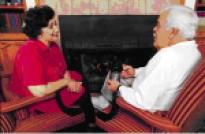 It may not be to your advantage to heed the advice of those who state a reverse mortgage should be a last resort or one should wait until they are older before doing one. Let’s explore why doing a reverse mortgage now rather than later may be to your advantage.
It may not be to your advantage to heed the advice of those who state a reverse mortgage should be a last resort or one should wait until they are older before doing one. Let’s explore why doing a reverse mortgage now rather than later may be to your advantage.
First you must know the Principal Limit or Loan Amount of the HUD insured Home Equity Conversion Mortgage (HECM) reverse mortgage is based on the age of the youngest borrower, the lesser of the home value or FHA Lending Limit and the program chosen and the Expected Interest Rate. HUD allows certain types of properties to qualify: single family homes, duplexes or 1 to 4 unit properties as long as the home owner is living in one of the units, townhomes, FHA approved condos, and manufactured homes that meet HUD’s requirements.
Continued Decline in Real Estate Values and Sales Volume
It appears that the real estate values have not yet stabilized so with potential continued decline in home values, one will receive less funds from the reverse mortgage in the future. To determine the value of the home the appraiser must use homes that are similar in size, number of bathrooms, bedrooms, style, etc. and that have sold in the last 6 months. If homes in the area are selling for lower values and/or are foreclosures which means less comparables are available and the homes are valued lower. So before the home values continue to decline, doing the reverse mortgage now will mean more funds will be guaranteed to be available based on the current value. (Note once the loan closes the funds are guaranteed available to borrowers as long as they meet the terms of the loan.)
Properties that qualify
HUD already has restrictions on condos that are not FHA approved making it difficult to do a reverse mortgage on condos. (The spot condo approval was removed in 2010.) We are seeing lenders add manufactured homes, log homes, berm, and rural homes to their list of ineligible homes. While there are still some lenders who continue to lend on these properties, this may change in the future and they are likely to tighten the underwriting requirements for these types of properties. If you are in one of these properties you should look at doing a reverse mortgage now while it’s still an option.
Ron who has a manufactured home was in the process of doing his reverse mortgage however during the processing of his loan the lender the loan was being done through changed their underwriting requirements. Now to proceed with his loan has to be put through another lender. If other lenders change their underwriting requirements he would not be able to do his reverse mortgage.
Reduced Principal Limits
In 2009 and 2010 HUD reduced calculation of the Principal Limit (Loan Amount) by 10% each year. In 2010 HUD increased their on-going annual FHA Mortgage Insurance Premium. While we have not heard this is happening again, given the real estate market and the political climate, HUD may find it necessary to decrease the Principal Limit again and/or increase the FHA Mortgage Insurance Premiums. Waiting may mean less funds are available if HUD reduces the Principal Limit.
No Servicing Fees/Set-Asides
Currently most reverse mortgage programs don’t have a service fee or service set-aside. However servicing fees may return in the future which means the service fee set-aside will reduce the net Principal Limit available to borrowers. Taking advantage of no servicing fee means more funds are available now.
Higher Expected Interest Rates Equals Less Funds Available
With FHA Reverse Mortgages the Expected Interest Rate is calculated weekly and is used to determine initial funds available. The Expected Interest Rate is considered a long term projection of future interest rates. Currently the Expected Interest Rate is below HUD’s floor of 5% which means more funds are available. (Expected Interest Rates at 5% or below have the same Principal Limit.) As the Expected Interest Rate changes to a higher rate, in the future less initial funds could be available to borrowers. It is unknown as to the timing of when the rates may rise but at some point they will for sure go up.
Even if the home value increases in the future the amount available on the reverse mortgage could be the same or less if you wait to do a reverse mortgage.
Let’s compare doing a reverse mortgage now to waiting 5 years before doing your reverse mortgage.
|
TODAY |
5 Years from now |
Initial Interest Rate is currently below 3% |
| AGE |
70 |
75 |
| HOME VALUE |
$200,000 |
$225,000 |
| *Based on Expected Rate of |
4.39 |
7.515 |
| AVAILABLE (Approximate net after fees) |
$122,690 |
$97,687 |
| DIFFERENCE |
$25,003 |
|
| These are all estimates. Different assumptions would result in different numbers. Interest rates are based on rates of 10/4/2011. |
Keep in mind, with an Adjustable Rate Reverse Mortgage funds left in a Line of Credit grow. So if you have $122,690 in your line of credit today, in the future you could have more funds available to you. Here’s an estimated example:
| Line of Credit Growth* |
No Draws |
Draw $5,000 each year |
| Today |
$122,690 |
$122,690 |
| Year 1 Balance |
$127,357 |
$122,357 |
| Year 2 Balance |
$132,201 |
$122,011 |
| Year 3 Balance |
$137,230 |
$121,652 |
| Year 4 Balance |
$142,450 |
$121,279 |
| Year 5 Balance |
$147,868 |
$120,892 |
| *Growth Rate based on Assumption of Expected Interest Rate of 3.739% in this example. Actual Line of Credit Grows based on current interest rate plus 1.25%. |
What would it be like for you to have security knowing you readily have funds available in your Line of Credit without paying additional closing fees in the future? When you use the funds each year you will be taking advantage of having the money you need during your retirement years and the benefit of improved financial health.
Lucy stated, “Having done the reverse mortgage has given me a new sense of security.”
Eliminate Mortgage Payments, Have Lower Interest Expense by Paying Off Your Conventional Mortgage
In addition to a lower interest rate* with a reverse mortgage, eliminating your monthly payment will improve your cash flow because you don’t have to payout that monthly payment each month. While the loan balance will rise because you are not making payments, the reverse mortgage is non-recourse which means there is no personal liability to you or your estate if the loan balance is higher than what the home can be sold at fair market value in the future. And you have the use of the funds to use during the term of the loan for whatever you need or want. By doing the reverse mortgage earlier you have use of funds that otherwise would go toward your monthly payments. Why not improve your cash flow sooner than later?
Note that you do have the option of making payments with your reverse mortgage – it’s just not required. You can choose when, how often and how much you want to pay. When payments are made the payment reduces the loan balance and with the adjustable rate will be applied to the Line of Credit meant it’s available in the future.
*Historically the HECM reverse mortgage interest rate is lower than what one can generally qualify for with a conventional mortgage.
Higher Valued Home Owners Should Do A Reverse Mortgage Before The Lending Limit Is Reduced
Currently the FHA HECM (Home Equity Conversion Mortgage) Lending Limit is $625,500. While we have not received final notice from HUD, word was received that the Lending Limit would remain at the $625,500 through FY 2012 – but this is an unknown. At some point this rate could be reduced to $417,000 or be based on a Lending Limit in the county where one lives. What this means is that if your home is valued more than the Lending Limit amount you can receive is based on the Lending Limit rather than the home value. For example if your home is appraised at $700,000, currently we would use $625,500 to determine the reverse mortgage Principal Limit. January 1, 2012 or after, we would be mandated to use $417,000 (or the county lending limit) for this calculation, making a big difference on the amount one can receive. If you have a higher valued home look at doing your reverse mortgage now instead of waiting until 2012 or after.
 Mary, a Minnesota Reverse Mortgage borrower whose home value, as most homes, had decreased over the last few years chose do to the reverse mortgage at the time instead of waiting even though she didn’t have any mortgages to pay off and didn’t have immediate needs for the funds. Her decision was based on the fact that if she waited her home value may continue to decrease whereas if she did the loan now she would have the funds in the line of credit for future use and they would grow so more funds would be available when she needs them. Additionally if she waited the Expected Interest Rate (used to determine how much can be loaned) may be higher making less funds available to her to her in the future.
Mary, a Minnesota Reverse Mortgage borrower whose home value, as most homes, had decreased over the last few years chose do to the reverse mortgage at the time instead of waiting even though she didn’t have any mortgages to pay off and didn’t have immediate needs for the funds. Her decision was based on the fact that if she waited her home value may continue to decrease whereas if she did the loan now she would have the funds in the line of credit for future use and they would grow so more funds would be available when she needs them. Additionally if she waited the Expected Interest Rate (used to determine how much can be loaned) may be higher making less funds available to her to her in the future.
We’ve talked with seniors whom we originally talked with 2, 3 or 4+ years go and had educated them about the reverse mortgage option. At that time they decided to wait and not do a reverse mortgage. Some even did a conventional mortgage or what we in the industry call a “forward” mortgage. “Life has happened” and they decide they now want to do the reverse mortgage. Unfortunately with many of these seniors we have to tell them the sad news that less funds are available now and in some cases there aren’t enough proceeds to pay off their current mortgage. They can be short $6,000, $10,000 and sometimes $30,000 or more. This is due to decreased home values and changes in the Principal Limit. We are finding this can also be the case for even those we talked with just 6 months ago.
Now a few years after Mary did her reverse mortgage, Mary is still happy with her decision to do have done her reverse mortgage sooner than later. She has security knowing she has funds available for her needs, independence to live on her own without relying on others for financial support, she’s maintained her dignity of being able to pay her own bills, and continues having control of her life and the ability to make her own choices.
Doing a reverse mortgage now may be to your advantage. Are you ready to live with more now? And to have security, independence, dignity and control in your retirement?
Note that I am not posting this as sales pitch, rather to make you aware of anticipated changes so you can make the best decision for your situation.
© 2011 Beth Paterson, Beth’s Reverse Mortgage Blog, 651-762-9648
This material may be re-posted provided it is re-posted in its entirety without modifications and includes the contact information, copyright information and the following link: http://wp.me/p4EUZQ-uP
Related articles:
Blog posts’ information is current as of date post published, program is subject to change in in the future. Contact us for current information, 651-762-9648.
This site or the information provided is not from, or approved by, HUD, FHA, or any US Government or Agency
 My reverse mortgage borrowers often call to say “Thank you!” for helping them obtain their reverse mortgage. They proceed to tell me what a difference it has made in their lives as well as for their families. I always appreciate hearing from them as well as hearing their stories.
My reverse mortgage borrowers often call to say “Thank you!” for helping them obtain their reverse mortgage. They proceed to tell me what a difference it has made in their lives as well as for their families. I always appreciate hearing from them as well as hearing their stories.

 A Home Equity Conversion Mortgage or HECM, also known as a reverse mortgage, is a mortgage which allows seniors 62 and over to convert the equity of there home into cash. Unlike a conventional mortgage, with the HUD insured HECM there are no monthly mortgage payments required. Instead the borrowers have options on how they want to receive the cash “paid” to them: a lump sum, monthly payments, a line of credit, or a combination of these. It shouldn’t be looked at as “one size fits all.” One needs to evaluate the different options to decide which is best for their situation. Let’s review them here.
A Home Equity Conversion Mortgage or HECM, also known as a reverse mortgage, is a mortgage which allows seniors 62 and over to convert the equity of there home into cash. Unlike a conventional mortgage, with the HUD insured HECM there are no monthly mortgage payments required. Instead the borrowers have options on how they want to receive the cash “paid” to them: a lump sum, monthly payments, a line of credit, or a combination of these. It shouldn’t be looked at as “one size fits all.” One needs to evaluate the different options to decide which is best for their situation. Let’s review them here. A line of credit
A line of credit

 It may not be to your advantage to heed the advice of those who state a reverse mortgage should be a last resort or one should wait until they are older before doing one.
It may not be to your advantage to heed the advice of those who state a reverse mortgage should be a last resort or one should wait until they are older before doing one. 







